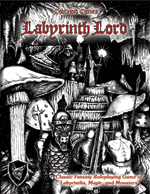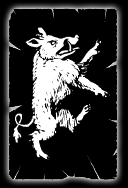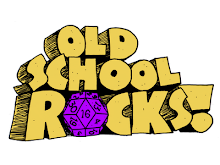I entered the RPG'ing hobby circa 1982, during the period James Maliszewski has dubbed the "Late Golden Age" or "Electrum Age," when TSR was beginning to transition D&D away from sandbox- and module-based play toward the more narratively driven campaign settings that characterize the "Silver Age" (1984-1989). In some ways, I came onboard too late to really be aware of the game's 1970s "gonzo," swords-and-planets, sandboxy origins, even though I read ERB's Barsoom books obsessively in junior high school. In terms of my taste in FRPG settings / adventures, I was more of a Tolkien-influenced high-fantasy guy, and felt, for example, that Gygax's Expedition to the Barrier Peaks was a strange anomaly in the D&D product line that came way out of left field. (I now happily understand the error of my ways on that score.)
I also never even heard of a megadungeon in those days, even though I was entranced by that awesome cross-section of Stone Mountain in the Holmes rulebook:
So my early training in how to play D&D was influenced most by TSR's early 1980's emphasis on releasing adventure modules that were published as one-offs and/or originally geared for tournament play, such as B2 The Keep on the Borderlands, C1 The Hidden Shrine of Tomoachan, S1 Tomb of Horrors, and my all-around favorite in those days, S2 White Plume Mountain. Even when I started playing in and eventually running longer campaigns, those campaigns tended to be structured as chains of strung-together module-based adventures, with maybe a bit of town adventuring in between. But again, not a megadungeon in sight. (Though, to be fair, not much over-arching narrative either.)
This led (or at least contributed) to a style of play that (I now realize) was more acquisitive than exploratory. Strangely -- especially given my extreme resistance to min-maxing and excessive game-ism nowadays -- my friends and I in those early days were all about the treasure, and the main (and possibly only) way we were interested in acquiring that treasure was by killing monsters. That was it. We wanted lots of monster encounters with lots of combat, then we wanted to find and loot big treasure hoards kept by the monsters we'd just slaughtered. End of story.
Of course, slaughtering monsters and looting treasure hoards are excellent goals for D&D PCs to have, and I am not saying we shouldn't have been excited by those activities. But I think some of the finer nuances of dungeon exploration were lost on us in the early years. No, we entered White Plume Mountain, knew there were some badassed artifact weapons in there, and we made as much of a beeline as possible toward the locations with the boss monsters so we could get our greedy hands on Wave! Relatively empty chamber with a bunch of mysterious floating globes? Intricate murals on the wall depicting ancient battles? Screw that, we want something to fight!
To be clear, this tendency of my junior high and high school years is absolutely NOT the fault of those excellent modules. Even the relatively straightforward White Plume Mountain has a great number of interesting tricks up its sleeve (discs over lava pools, anyone?), to say nothing of even more open-ended modules such as D3 Vault of the Drow or Q1 Queen of the Demonweb Pits. I have no idea what my group would have done with D3 in those early days -- probably started a minor civil war with the wrong Drow faction and gotten wiped out by Drow clerics long before finding the Fane of Lolth.
But thank goodness I have begun to learn the Old Ways! I look at those early modules with such different eyes now, and -- thanks in large part to James M.'s Dwimmermount campaign reports, the wisdom of so many other OSR bloggers, and (most impactfully) Michael Curtis' AWESOME megadungeon, Stonehell -- I am (in my very late 30's) finally grokking what is so fulfilling about sandbox / megadungeon play. The main thing is that it emphasizes exploration over (or at least in conjunction with) encounters. Taking on a megadungeon the size of Stonehell does not allow a party to be as cavalier as my buddies and I were about traipsing into White Plume in the 1980s. No, its sheer magnitude and its ever-evolving nature require much finer attention to detail, and encourage a certain degree of planning and preparation that one-off module-based play does not so strongly motivate.
For example, in recent sessions of my Arandish campaign, the PCs left Stonehell to rest and re-equip in a nearby town, only to find that when they returned to the megadungeon site a couple sessions later, the hobgoblin Occupational Army encamped atop the south ridge of the box canyon had increased its numbers and its patrol range. Thus the PCs simply could not reenter the megadungeon the way they had gone before unless they wanted to fight their way past a legion of well-armed hobgoblins!
My players seem to understand that mapping is essential in megadungeon exploration. My junior-high friends and I usually mapped in our early AD&D module-playing days, but I don't think we had quite the same sense of urgency about it as my PCs do now. Given the size of Stonehell and the shifting territorial boundaries of the various monster factions within, mapping in Stonehell is a crucial survival technique. I like that.
What I like most about megadungeon play -- and again, KUDOS to Michael Curtis for teaching me this through the excellent example of Stonehell -- is that it encourages, even requires, the party to slow down, check out each nook and cranny, and really soak in the atmosphere of the place. As a DM, I love that part of the process: immersing the players and myself alike in the feel of the game-world. (And here I must also mention the influence of James Raggi, who is arguably the Grand Master of setting a unique atmosphere in a dungeon.) For me nowadays, that is where the real fun and feeling of escape in RPG'ing comes from. Which is not mutually exclusive of kicking a bunch of monsters' asses and looting treasure with great abandon, but it is an added dimension of RPG'ing that I never knew I was missing in those early days in the Electrum and Silver Ages of the hobby.
Random Thoughts & Links for 4/26/2024
8 hours ago













































